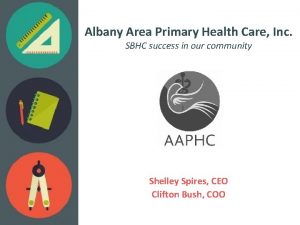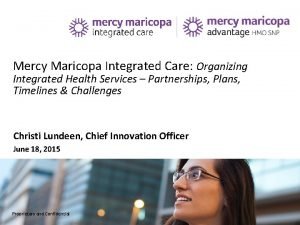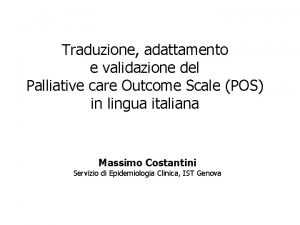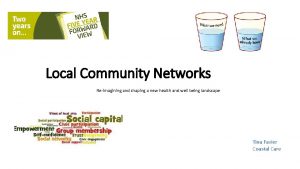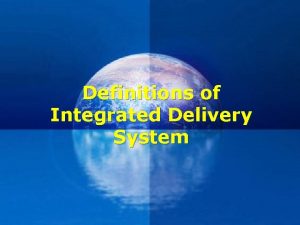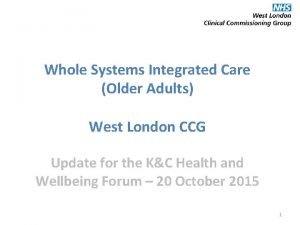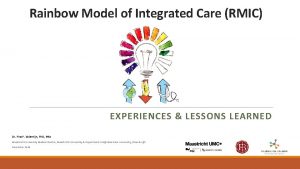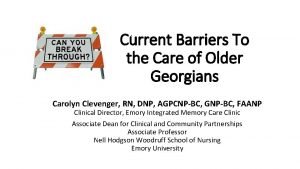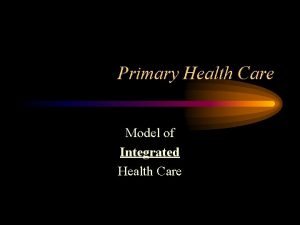Integrated Care in NSW Presentation to NSW Rural















- Slides: 15

Integrated Care in NSW Presentation to NSW Rural Health & Research Congress Dubbo, 9 September 2014 Katherine Burchfield Director, Integrated Care Branch NSW Ministry of Health

Content Why Integrated Care? What does it mean? The NSW Integrated Care Strategy 1

Various drivers are placing increasing pressure on our health system Growing and ageing population Increased number of people living with chronic diseases Increased demands from people with complex needs Societal changes Reduction in length of stay and productivity targets Increasing demands on the health system Increasing specialisation in medicine and nursing Rising consumer expectations 2

The current system is episodic and fragmented, focused on patient outcomes by exception Health promotion Planned care at home Outpatient care close to home Residential aged care Planned inpatient care “Systems designed to treat occasional episodes of care for normally healthy people are being used to deliver care for people who have complex and long term conditions. Unplanned hospital care The result is that they are passed from silo to silo without the system having the ability to co-ordinate different providers” S Dorrell, NHS Health Service Journal, 2011 Current system tends to supports short term episodic care rather than long term health and functionality 3

Why NSW needs integrated care Ageing population • The NSW population is expected to grow by about 1% per annum • Over 65 s will represent ~20% of the population in 2030 compared to 14% in 2006 • Healthcare expenditure for over 65 s is two to three times higher than under 65 s Increase in chronic disease • Prevalence of chronic disease expected to increase by 15 -20% in 2030 • Total number of chronic diseases to increase by ~1 M (+33%) in 2030 Increase in hospitalisations and GP visits • Length of stay has decreased but hospital separations have increased, resulting in an increase in bed days between 2006 and 2011 • Number of bed days to increase by 51% to 9. 7 m in 2030 • Number of GP visits to increase by 64% to 56 m in 2030 Increase in need for health workforce • − − − Increase in need for hospitals • An additional 10, 000 beds or ~114 hospitals will be required in 2030 Health workforce required to grow by 30 -100% by 2030 36% more nurses 97% more physicians 30% more allied health professionals 4

Better integration of care will help to achieve a more sustainable health system Today • • Fragmented Episodic Inefficient Unsustainable Tomorrow Integration of care ? Integrated, sustainable health system 5

Content Why Integrated Care? What does it mean? The NSW Integrated Care Strategy 6

What is integrated care? Integrated Care meets a person’s needs by providing seamless, effective and efficient care, organised for, by and with the person, from prevention through to end of life. Care is person centred Care is a seamless continuum Care is effective Care is efficient Care is organised for, by and with the person by bringing care to the person’s community or home rather than the person to the care Care is organised across spectrum of care ranging from social and preventative, to primary and acute, through to aged and end-of-life care Care results in the outcomes that are desired by the patient and reflect achieved health status, recovery process and sustainability of health Care makes efficient use of both financial and human resources Value-based healthcare 7

Content Why Integrated Care? What does it mean? The NSW Integrated Care Strategy 8

NSW State Health Plan • NSW State Health Plan launched in June 2014. • Three clear directions for the future delivery of healthcare in NSW Direction One: Keeping People Healthy Direction Two: Providing World Class Clinical Care Direction Three: Delivering Truly Integrated Care 9

Announcement Jillian Skinner MP Minister for Health Minister for Medical Research MEDIA RELEASE Thursday 20 March 2014 NSW GOVERNMENT COMMITS $120 MILLION TO INTEGRATED HEALTH CARE The NSW Government will spend $120 million over four years to provide seamless care to people in an integrated way - from care in the community to acute care in hospital. Health Minister Jillian Skinner was joined at Parliament House today by community providers including general practitioners (GPs) and non-Government organisations (NGOs) as well as representatives of the primary care sector including pharmacies and private hospitals as she launched the Integrated Care in NSW strategy. Mrs Skinner described the NSW Government’s new focus on integrated care as a transformative step for health care in this state …. 10

The NSW Integrated Care Strategy has three components $120 M investment over 4 years Description Goal Indicative % funding Focused on information technology infrastructure, outcomes measurement and patient feedback, capacity building and evaluation. Establish key enablers of integrated care benefiting all LHDs and stakeholders 27% Planning and Innovation Fund Investment in individual initiatives and planning at the local level, including extension of successful integrated care approaches from the Demonstrators. Support local planning, collaboration and innovation initiatives 31% Integrated Care Demonstrators LHD-led Demonstrators in Western NSW, Central Coast and Western Sydney focused on large-scale transformation of integrated local health systems and testing initiatives prior to extension across the State. Develop system-wide integrated care approaches in three LHDs that are transferrable and scaleable 42% Statewide enablers Implementation will involve partnerships with primary care organisations, NGOs and private providers 11

The Strategy seeks to build and link on existing initiatives 12

Expected benefits Better patient experience Improved outcomes • • • Easier navigation of the system Reduced waiting times Increased satisfaction • • Better patient reported outcomes Improved long term health outcomes • Fewer avoidable hospitalisations and ED attendances Less duplication of services/tests Less waste • 13

Opportunities in rural NSW • Regional planning for health services and wider determinants of health • Move beyond consultation & coordination to true partnerships with primary care, aged care providers, and Aboriginal Community Controlled Health Services (ACCHS) • New funding and business models – particularly for community-based health services - that optimise workforce and funding streams • Improve IT infrastructure and information flow, including outcomes monitoring and feedback • Leverage MPS and service co-location ‘hubs’ • Further embed telehealth and m-health • Greater use of telephonic solutions eg. Health. Direct • Explore the most cost effective pathways for supporting ‘health’ of remote populations • Promote prevention and early intervention • Consumer/community engagement, health literacy and self management 14
 Integrated rural tourism
Integrated rural tourism Primary secondary tertiary health care definition
Primary secondary tertiary health care definition Albany area primary health care dental
Albany area primary health care dental Rural health care
Rural health care Cumbria and north east ics
Cumbria and north east ics Mercy maricopa
Mercy maricopa Traduttore italiano inglese
Traduttore italiano inglese Cissbury integrated care
Cissbury integrated care Integrated care delivery system
Integrated care delivery system St charles integrated care centre
St charles integrated care centre Pim valentijn
Pim valentijn Imcc emory
Imcc emory Family integrated care
Family integrated care Integrated primary health care model
Integrated primary health care model Mhc fully integrated managed care
Mhc fully integrated managed care Diameters of fetal head
Diameters of fetal head


